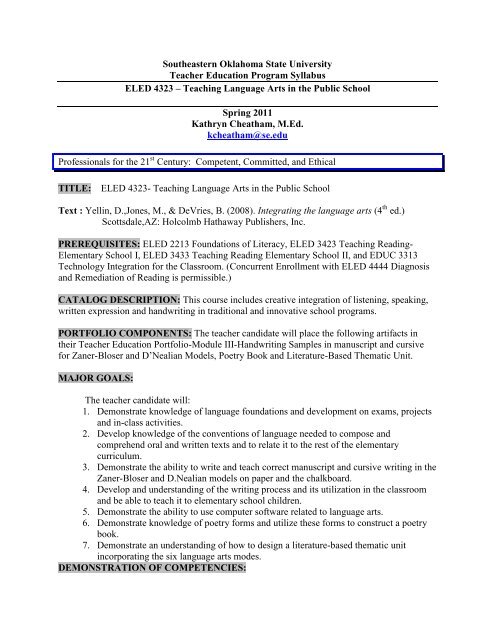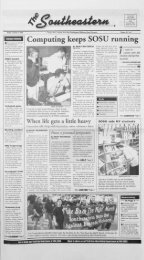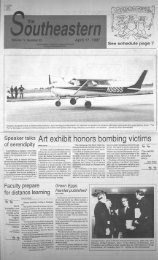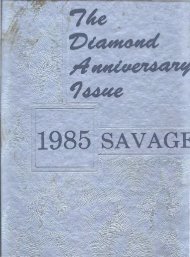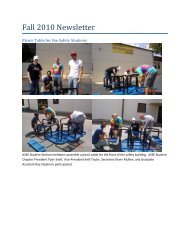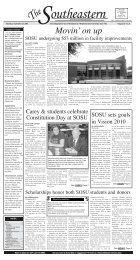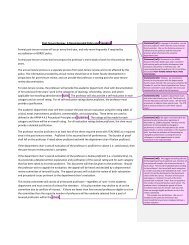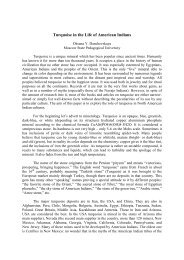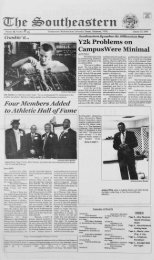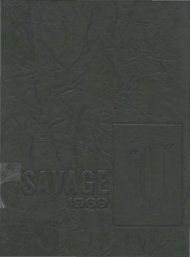ELED 4323 Teaching Language Arts in the Public School
ELED 4323 Teaching Language Arts in the Public School
ELED 4323 Teaching Language Arts in the Public School
You also want an ePaper? Increase the reach of your titles
YUMPU automatically turns print PDFs into web optimized ePapers that Google loves.
Sou<strong>the</strong>astern Oklahoma State University<br />
Teacher Education Program Syllabus<br />
<strong>ELED</strong> <strong>4323</strong> – <strong>Teach<strong>in</strong>g</strong> <strong>Language</strong> <strong>Arts</strong> <strong>in</strong> <strong>the</strong> <strong>Public</strong> <strong>School</strong><br />
Spr<strong>in</strong>g 2011<br />
Kathryn Cheatham, M.Ed.<br />
kcheatham@se.edu<br />
Professionals for <strong>the</strong> 21 st Century: Competent, Committed, and Ethical<br />
TITLE: <strong>ELED</strong> <strong>4323</strong>- <strong>Teach<strong>in</strong>g</strong> <strong>Language</strong> <strong>Arts</strong> <strong>in</strong> <strong>the</strong> <strong>Public</strong> <strong>School</strong><br />
Text : Yell<strong>in</strong>, D.,Jones, M., & DeVries, B. (2008). Integrat<strong>in</strong>g <strong>the</strong> language arts (4 th ed.)<br />
Scottsdale,AZ: Holcolmb Hathaway Publishers, Inc.<br />
PREREQUISITES: <strong>ELED</strong> 2213 Foundations of Literacy, <strong>ELED</strong> 3423 <strong>Teach<strong>in</strong>g</strong> Read<strong>in</strong>g-<br />
Elementary <strong>School</strong> I, <strong>ELED</strong> 3433 <strong>Teach<strong>in</strong>g</strong> Read<strong>in</strong>g Elementary <strong>School</strong> II, and EDUC 3313<br />
Technology Integration for <strong>the</strong> Classroom. (Concurrent Enrollment with <strong>ELED</strong> 4444 Diagnosis<br />
and Remediation of Read<strong>in</strong>g is permissible.)<br />
CATALOG DESCRIPTION: This course <strong>in</strong>cludes creative <strong>in</strong>tegration of listen<strong>in</strong>g, speak<strong>in</strong>g,<br />
written expression and handwrit<strong>in</strong>g <strong>in</strong> traditional and <strong>in</strong>novative school programs.<br />
PORTFOLIO COMPONENTS: The teacher candidate will place <strong>the</strong> follow<strong>in</strong>g artifacts <strong>in</strong><br />
<strong>the</strong>ir Teacher Education Portfolio-Module III-Handwrit<strong>in</strong>g Samples <strong>in</strong> manuscript and cursive<br />
for Zaner-Bloser and D’Nealian Models, Poetry Book and Literature-Based Thematic Unit.<br />
MAJOR GOALS:<br />
The teacher candidate will:<br />
1. Demonstrate knowledge of language foundations and development on exams, projects<br />
and <strong>in</strong>-class activities.<br />
2. Develop knowledge of <strong>the</strong> conventions of language needed to compose and<br />
comprehend oral and written texts and to relate it to <strong>the</strong> rest of <strong>the</strong> elementary<br />
curriculum.<br />
3. Demonstrate <strong>the</strong> ability to write and teach correct manuscript and cursive writ<strong>in</strong>g <strong>in</strong> <strong>the</strong><br />
Zaner-Bloser and D.Nealian models on paper and <strong>the</strong> chalkboard.<br />
4. Develop and understand<strong>in</strong>g of <strong>the</strong> writ<strong>in</strong>g process and its utilization <strong>in</strong> <strong>the</strong> classroom<br />
and be able to teach it to elementary school children.<br />
5. Demonstrate <strong>the</strong> ability to use computer software related to language arts.<br />
6. Demonstrate knowledge of poetry forms and utilize <strong>the</strong>se forms to construct a poetry<br />
book.<br />
7. Demonstrate an understand<strong>in</strong>g of how to design a literature-based <strong>the</strong>matic unit<br />
<strong>in</strong>corporat<strong>in</strong>g <strong>the</strong> six language arts modes.<br />
DEMONSTRATION OF COMPETENCIES:
Competency #1. The teacher understands <strong>the</strong> central concepts and methods of<br />
<strong>in</strong>quiry of <strong>the</strong> subject matter discipl<strong>in</strong>e(s) he or she teaches and<br />
can create learn<strong>in</strong>g experiences that make <strong>the</strong>se aspects of<br />
subject matter mean<strong>in</strong>gful for students.<br />
Instruction:<br />
The concept of <strong>in</strong>struct<strong>in</strong>g students on how to model proper<br />
handwrit<strong>in</strong>g on <strong>the</strong> chalkboard and paper will be taught.<br />
Assessment:<br />
Competency will be considered achieved if <strong>the</strong> student presents<br />
a proper portfolio submission of handwrit<strong>in</strong>g samples <strong>in</strong> Zaner<br />
Bloser and D’Nealian.<br />
Instruction:<br />
The concept of <strong>in</strong>struct<strong>in</strong>g students on a variety of poems and<br />
apply<strong>in</strong>g that knowledge through writ<strong>in</strong>g poems to exemplify an<br />
understand<strong>in</strong>g will be taught.<br />
Assessment:<br />
Competency will be considered achieved if <strong>the</strong> student submits a<br />
poetry book for <strong>the</strong> portfolio.<br />
Competency #2. The teacher understands how children learn and develop, and<br />
can provide learn<strong>in</strong>g opportunities that support <strong>the</strong>ir <strong>in</strong>tellectual,<br />
social and personal development at all grade levels <strong>in</strong>clud<strong>in</strong>g<br />
early child-hood, elementary, middle level and secondary.<br />
Instruction:<br />
The concept of how to plan and deliver a literature-based<br />
<strong>the</strong>matic unit <strong>in</strong>clusive of <strong>the</strong> six modes of language arts and<br />
<strong>in</strong>tegrated curriculum will be taught.<br />
Assessment:<br />
Competency will be considered achieved if <strong>the</strong> student submits a<br />
literature-based <strong>the</strong>matic unit for <strong>the</strong> portfolio.<br />
Competency #3. The teacher understands that students vary <strong>in</strong> <strong>the</strong>ir approaches to
learn<strong>in</strong>g and creates <strong>in</strong>structional opportunities that are<br />
adaptable to <strong>in</strong>dividual differences of learners.<br />
Instruction:<br />
The concept of how to adapt and modify lessons to meet<br />
students’ <strong>in</strong>dividual learn<strong>in</strong>g styles will be taught.<br />
Assessment:<br />
Competency will be considered achieved if <strong>the</strong> student submits<br />
a <strong>the</strong>matic unit for <strong>the</strong> portfolio <strong>in</strong> which lesson plans and<br />
activities are developed to accommodate students’ levels of<br />
learn<strong>in</strong>g and modified to meet learn<strong>in</strong>g styles.<br />
Competency #4. The teacher understands curriculum processes and uses a variety<br />
of <strong>in</strong>structional strategies to encourage students’ development<br />
of critical th<strong>in</strong>k<strong>in</strong>g, problem solv<strong>in</strong>g, and performance skills<br />
and effective use of technology.<br />
Assessment:<br />
Competency will be considered achieved if <strong>the</strong> student submits<br />
a computer-generated schematic map for <strong>the</strong> <strong>the</strong>matic unit that<br />
provides a visual organizer of <strong>the</strong> key elements of <strong>the</strong> literature<br />
utilized.<br />
Competency #5. The teacher uses best practices related to motivation and<br />
behavior to create learn<strong>in</strong>g environments that encourage positive<br />
social <strong>in</strong>teraction, self motivation and active engagement<br />
learn<strong>in</strong>g; thus, provid<strong>in</strong>g opportunities for success.<br />
Assessment:<br />
Competency will be considered achieved if <strong>the</strong> student freely<br />
engages <strong>in</strong> dialogue and asks questions of <strong>the</strong> <strong>in</strong>structor and peer<br />
group dur<strong>in</strong>g <strong>in</strong>structional time and related <strong>in</strong>-class activities.<br />
CONCEPTUAL FRAMEWORK: The conceptual framework for <strong>the</strong> teacher education<br />
program at Sou<strong>the</strong>astern Oklahoma State University is based on <strong>the</strong> <strong>the</strong>me: Professionals for <strong>the</strong>
21 st century; competent, committed and ethical. The conceptual framework is consistent with <strong>the</strong><br />
mission of <strong>the</strong> University and is based upon research about best practices <strong>in</strong> education. It stems<br />
from <strong>the</strong> former <strong>the</strong>me: Teacher as Manager of Learn<strong>in</strong>g and is comprised of <strong>the</strong> four knowledge<br />
based doma<strong>in</strong>s; plann<strong>in</strong>g, deliver<strong>in</strong>g, motivat<strong>in</strong>g and assess<strong>in</strong>g. Plann<strong>in</strong>g is an essential aspect of<br />
effective teach<strong>in</strong>g which <strong>in</strong>volves develop<strong>in</strong>g and design<strong>in</strong>g daily, unit and long range plans for<br />
<strong>in</strong>struction. Deliver<strong>in</strong>g covers a broad range of <strong>in</strong>structional strategies and methods such as free<br />
<strong>in</strong>quiry through question<strong>in</strong>g, demonstration, presentation and performance. The delivery of<br />
<strong>in</strong>struction also refers to <strong>the</strong> educational practices related to creat<strong>in</strong>g learn<strong>in</strong>g environments that<br />
promote positive social <strong>in</strong>teraction, active <strong>in</strong>quiry, collaboration and engagement <strong>in</strong> educational<br />
experiences. Successful teachers are positive motivators. They create an enjoyable classroom<br />
environment which accommodates a variety of learn<strong>in</strong>g styles and <strong>in</strong>dividual differences.<br />
Assessment is vital to <strong>the</strong> program for teacher candidates. They learn that assessment can be used<br />
<strong>in</strong> a variety of ways to assess properly. They must collect, <strong>in</strong>terpret and syn<strong>the</strong>size data and use<br />
that <strong>in</strong>formation to modify <strong>the</strong> curriculum <strong>in</strong> such a way as to meet <strong>the</strong> needs of all <strong>the</strong>ir students.<br />
RESEARCH OF PROJECT COMPONENT: The student will compile a poetry book<br />
<strong>in</strong>clud<strong>in</strong>g a variety of poems that have been taught based on word and syllable count, free form,<br />
model, rhymed and formula types.<br />
The project requires that a table of contents, an author’s page and appropriate illustrations to<br />
accompany each of <strong>the</strong> poems be <strong>in</strong>cluded. Each of <strong>the</strong> poems must be labeled accord<strong>in</strong>g to<br />
which of <strong>the</strong> five major categories it fits.<br />
A second culm<strong>in</strong>at<strong>in</strong>g project <strong>in</strong> <strong>the</strong> course requires that students assemble a literature-based<br />
<strong>the</strong>matic unit <strong>in</strong> which children’s trade books are utilized. <strong>Language</strong> <strong>Arts</strong> students must design a<br />
schematic web page to <strong>in</strong>clude <strong>the</strong> titles of books, <strong>the</strong> specific modes utilized, and areas of<br />
<strong>in</strong>terdiscipl<strong>in</strong>ary curriculum that apply. The unit must <strong>in</strong>clude lesson plans and activities that are<br />
adapted to meet <strong>in</strong>dividual learn<strong>in</strong>g styles and modifications to meet <strong>the</strong> needs of all levels of<br />
learn<strong>in</strong>g. An annotated bibliography cover<strong>in</strong>g all <strong>the</strong> trade books is required.<br />
FIELD COMPONENT: The student will be <strong>in</strong>volved <strong>in</strong> a pen pal project with <strong>the</strong> public school<br />
at <strong>the</strong> second or third grade level. <strong>Language</strong> <strong>Arts</strong> students will meet with <strong>the</strong>ir pen pal at <strong>the</strong> end<br />
of <strong>the</strong> semester and plan an appropriate story tell<strong>in</strong>g activity us<strong>in</strong>g a self-constructed puppet.<br />
DIVERSITY COMPONENT: The teacher candidates will review <strong>the</strong> issues <strong>in</strong>volved with ESL<br />
students and multicultural education is <strong>in</strong>tegrated <strong>in</strong>to <strong>the</strong> subject matter. Biased assessment of<br />
students from diverse cultural groups will be addressed. A specific component of <strong>the</strong> course will<br />
deal with monitor<strong>in</strong>g students’ learn<strong>in</strong>g, utiliz<strong>in</strong>g portfolios and assign<strong>in</strong>g grades.<br />
PERFORMANCE ACTIVITIES: The follow<strong>in</strong>g enabl<strong>in</strong>g activities will be utilized:
1. Read<strong>in</strong>g assigned textbook chapters and relevant research articles.<br />
2. Lecture and participation <strong>in</strong> discussion on course topics.<br />
3. Participation <strong>in</strong> paired and/or small group activities.<br />
4. Construction of poetry book and <strong>the</strong>matic unit projects.<br />
5. Reflections based on textbook material and delivery of <strong>in</strong>struction.<br />
6. Proficiency of handwrit<strong>in</strong>g on paper and <strong>the</strong> chalkboard.<br />
ASSESSMENT:<br />
Handwrit<strong>in</strong>g Samples 30 pts.<br />
Poetry Book 50 pts.<br />
<strong>Teach<strong>in</strong>g</strong> Bullet<strong>in</strong> Board 30 pts.<br />
Thematic Unit 100 pts.<br />
Reflections (2) 30 pts.<br />
Pen pal Activity 50 pts.<br />
Grad<strong>in</strong>g Scale: 90-100 % A<br />
80-89% B<br />
70-79% C<br />
60-69% D<br />
Below 60 F<br />
SUPPLEMENTARY READINGS:<br />
Gunn<strong>in</strong>g, Thomas, G. (2002). Assess<strong>in</strong>g and Correct<strong>in</strong>g Read<strong>in</strong>g and Writ<strong>in</strong>g Difficulties.<br />
Yopp, Hallie Kay (2006). Literature-Based Read<strong>in</strong>g Activities.<br />
Gorski, Paul C. (2005). Multicultural Education and <strong>the</strong> Internet; Intersections and<br />
Integrations.<br />
SPECIAL ACCOMMODATIONS:<br />
Syllabus Statement: Any student need<strong>in</strong>g special accommodations due to a disability<br />
should contact <strong>the</strong> Coord<strong>in</strong>ator for Student Disability Services, Student Union, Suite 204 or<br />
call (580) 745-2254 (TDD# 745-2704). It is <strong>the</strong> responsibility of each student to make an<br />
official request for accommodations to <strong>the</strong> Coord<strong>in</strong>ator.


